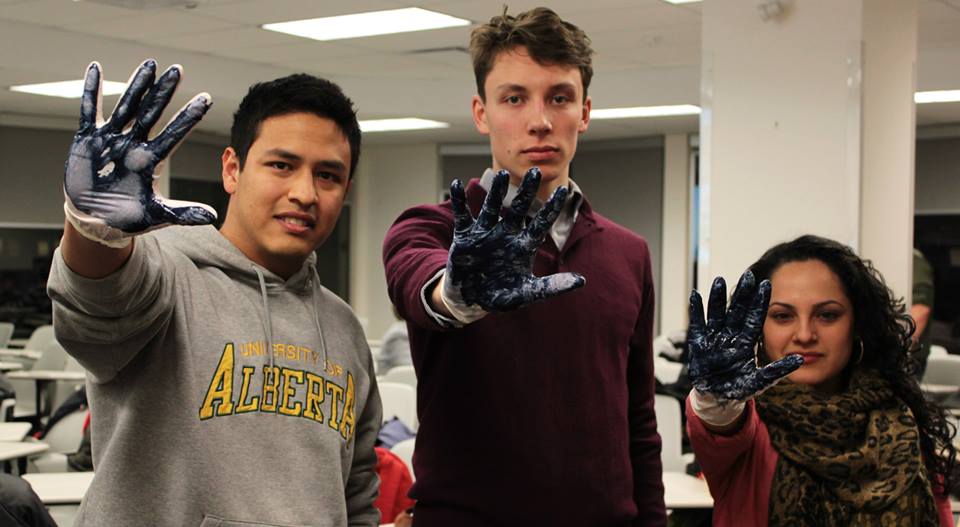On Friday April 22nd, organizers from Filipino groups such as Anakbayan, Migrante and the International Coalition for Human Rights held a silent protest inside the office of the Philippine Consulate General of Toronto, condemning the killings of peasant farmers demanding food relief in the Kidapawan Massacre at the hands of soldiers of the Armed Forces of the Philippines.
Their shirts read “BIGAS HINDI BALA” – “RICE NOT BULLETS”, calling on the Filipino diaspora to pay attention to deaths of two farmers, Enrico Fabligar and Darwin Magyao, as well as the injury, starvation, and detainment of many more, including pregnant women and the elderly. This action was the third in a series of actions that have taken place over the month of April, all with the aim of informing the public about the violent undermining of basic human rights and exploitation of peasants in the Philippines.
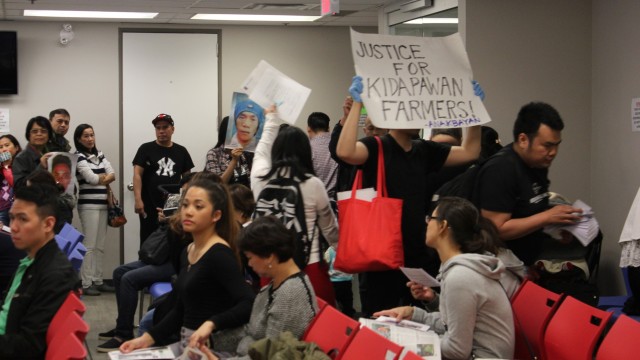
The Philippine Atmospheric, Geophysical and Astronomical Services Administration (PAGASA) had announced as early as September 30, 2015 that a ‘strong’ El Niño would disproportionately affect the Philippines. By January 20th, North Cotabato, a province on the island of Mindanao, had declared a state of calamity under which the Provincial Government is supposed to allocate at least 5% of its internal revenue as calamity funds to be given to those most affected by the drought. The Filipino state gave many declarations but no provisions for the starving farmers. Currently, no funds from the Calamity Fund have reached the farmers.
By the end of March 2016, 40% of the country had experienced the drought; by the end of April, it would be 85%. The Peasant Movement of the Philippines, Kilusang Magbubukid ng Pilipinas (KMP), which is part of a larger network of organizations known as Bayan, mobilized its chapters in Mindanao to compel the state to address the drought. From March 28th to March 29th, 6,000 farmers and their families from different towns protested near the National Food Authority Office and the Spottswood Methodist Center in Kidapawan City, North Cotabato.
The farmers called upon the government for the release of 15,000 sacks of rice to respond to the drought; the subsidy of rice, seedlings, fertilizers, and pesticides until the drought ends; an increase in farmgate prices of agricultural products; the pullout of military troops in their communities; and the investigation and disbandment of the Bagani paramilitary group being formed by Rep. Nancy Catamco, who are used to terrorize and control the farmers.
Instead of providing them with rice and seedlings, the Philippine National Police and SWAT personnel violently forced the peasants to leave the area by gunning them down, hitting them with batons, throwing stones and blasting them with water cannons from their fire trucks. After the compound was cleared, it was surrounded by some 200 police and the 39th Infantry Battalion of the Armed Forces of the Philippines (AFP).
The drought and violent treatment of farmers is connected to a pattern of reactionary state violence from the Filipino government, who depends on exploiting farmers at home with the aid of rich Western governments. Petronida Cleto, one of the organizers of the protest, connects the treatment of Filipino farmers to those who migrate to countries like Canada: “The system in the Philippines is very export-oriented. They facilitate the movement of people by forcing peasants to sell their possessions to pay multiple fees, forced to sell land to go abroad. And for what? To get Permanent Residency after two years of slavery?!”
Rich Western nations like Canada go to the Third World to extract the resources and labour power of countries like the Philippines. Due to the conditions in their country caused by this resource extraction, Filipino people are forced to leave their homes and families behind in search for work in order to survive. Canada’s Temporary Foreign Worker Program is one way this exploitation takes place because it enables the Canadian State to exploit the labour of Filipino migrants, while at the same time stealing land from peasants, all for its own economic gains.
Organizers aim to raise awareness about the oppressive political climate of the Philippines, where “farmers are not allowed to own their own land, and are killed when they try to stand up and defend it,” said Jesson, one of the main organizers of Friday’s action in Toronto. “This action was about showing that the Filipino community condemns this State-sponsored terrorism and the stealing of land from peasants.”
According to the final report of the National Fact-Finding and Humanitarian Mission (NFHM) of Kidapawan City, it is estimated that 1% of the population in the country own 20% of the total 13.34 million hectares of agricultural lands. Farmers toil day in and day out to produce crops only to have them taken away by huge multinational corporations like Del Monte. They are unable to sustain themselves and are then killed when they ask for what is rightfully theirs to begin with. These are the types of inequalities that the private ownership of land and goods results in, where a small portion of the population profits from the exploitation of the majority who are farmers and peasants.
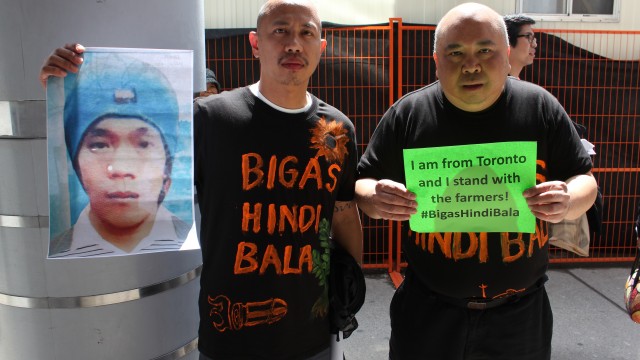
The state steals and sells the labour of the people to western multinational companies, but the Filipino people do not stand unorganized. The NFHM was conducted within a matter of days after the massacre. Bayan and the KMP mobilizes the peasants based on the fact that they are the farmers of the land. A third of the Philippines’ population is made up of agricultural workers – revolutionary organizations awaken the power of the masses, who already have the skills to maintain their own survival.
When the government watched their people starve, organizations within Bayan like the KMP mobilized 6,000 people to rise and demand that the state open up its stolen resources to the rest of the population. When Gov. Taliño-Mendoza refused to meet the farmers’ demands, offering only three kilos of rice per family once every three months, the peasant leaders unified to reject this offer. The peasants are not asking for charity or handouts; they are demanding the resources they produced from their own land and labour.
Landlords, just like the state, did not miss the opportunity to watch peasants starve. Some have even gone so far as to hoard tonnes of rice in order to drive up prices and increase their profits. The government of the Philippines has done nothing to address this issue, but the New People’s Army (NPA) has taken direct action to reclaim the rice that had been produced by the peasants who are now purposefully being starved by the government and shot at by its army.
The NPA strategically targeted Helen Bernal, who was hoarding more than a tonne of rice. They stormed her warehouse and confiscated 1,384 sacks of rice, along with CCTV monitors, sanding tools, and other electronic equipment in Valencia City, Bukidnon in the country’s southern region. The NPA then redistributed the stolen possessions directly to the places that were most affected by the drought, giving farmers the much needed rice that they had been demanding from the government but were denied, having been served bullets instead.
The deeply organized peasant class, in cities such as Kidapawan and Valencia, along with their comrades in Canada, have the power to hold the corrupt Filipino state accountable. This confrontation clearly shows that organizing and collectivist action is the only way for the peasants to survive and empower themselves during disasters, both “natural” and government-inflicted. The people, when united, will never be defeated. They will only grow stronger.
Photos by Nooria Alam
]]>by Steve da Silva
The writing on the wall couldn’t have been written in bigger, bolder, and clearer letters over the past year: The relentless exploitation of fossil fuel is rushing the planet beyond a series of irreversible environmental tipping points. Melting glaciers. Acidifying oceans. An atmosphere reaching carbon levels not seen in millions of years. We are in the midst of what scientists call a “mass extinction” event that is directly attributable to capitalist economy. Species are being killed off at 1000 times the ‘background rate’ or normal rate at which species statistically go out of existence.
This is the context in which the National Energy Board and the Federal cabinet approved Enbridge’s Northern Gateway project, which plans to lay 1200 km of pipeline carrying diluted bitumen from Alberta to a northwest coast shipping terminus at Kitimat, B.C.
Last week’s decision was expected to yield a positive decision for the oil industry. In December 2013, a three-member Joint Review Panel – ostensibly “independent” from but mandated by the Ministry of Environment and the National Energy Board (NEB) – issued a report recommending approval for the project subject to the 209 conditions that the Federal cabinet last week set for the project’s go ahead. But this report has been analyzed as deeply flawed by the actually independent experts.
Scientific Opposition
On May 26, 250 members of the scientific community from throughout Canada and across the world published an Open Letter criticizing the “flawed analysis” of the Joint Review Panel’s assessment of the Northern Gateway project. As the letter highlighted who benefits and who will pay for Northern Gateway by drawing attention to the JRP’s “broad view of the economic benefits, but an asymmetrically narrow view of the environmental risks and costs.” The Open Letter concluded deemed the Joint Review Panel Report “as indefensible as a basis to judge in favour of the project.”
The Open Letter from scientists also brought attention to the proverbial elephant in the middle of the room: the Joint Review Panel’s complete exclusion of considerations for the increase in greenhouse gas emissions.
Climatologists argue that the proportion of atmospheric carbon that humans have evolved over the last couple hundred thousand years has been around 275 parts per million (ppm) of atmospheric molecules. As of the end of May 2014, the carbon content of the atmosphere stood at 400 ppm, well above the 350ppm that climatologists argue is necessary to preserve the current ecological equilibrium on earth. The relentless expansion of the fossil fuel industry into hydraulic fracturing (“fracking”), deep sea drilling, and oil sands is sealing the fate on irreversible ecological catastrophes.
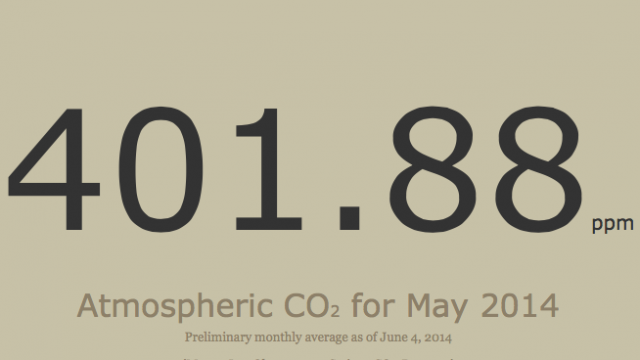
The carbon content of the atmosphere as of May 2014, already a disastrous and climate changing level according to scientists, and climbing at a rate of 2 ppm / year and accelerating.
Northern Gateway to Where? Who benefits?
But none of this seems to matter to industry heads focused on their “bottom lines”. Since the financial collapse of 2007/08, corporations have been all the more desperate for profitable investment opportunities that seem increasingly elusive. But intensified resource exploitation is a seeming to be a sure-fire way for Canada to keep itself at the apex of a stagnant, crisis-ridden and profit-based capitalist world economy.
The planned and now approved pipeline would see an estimated 220 oil tankers port and load at Kitimat each year. Each day, the pipeline would fill 525,000 barrels of oil – a carrying capacity that Alberta’s oil industry is hungry for. In 2013, Alberta’s tar sands were already producing 1.95 million barrels a day, and the industry is planning for an upward expansion to 3.2 million barrels a day by 2020. This is why industry is hedging its bets with the southward flowing expansion of Keystone XL. When U.S. President Obama suspended the expansion of Keystone XL in 2011, Canada’s oil industry turned to Asia to become a new destination for its oil supplies.
If Northern Gateway goes online, it is estimated that it will bring tax revenue to B.C. of $1.2 billion dollars over a thirty year period. That’s less than $40 million a year. But these revenues are vastly dwarfed by the estimated clean-up costs of an oil spill on the northwest coast, which is estimated to range from anywhere between $2-$10 billion for such a disaster. Yet, for all the risks and costs, Enbridge is only claiming that the project will yield a mere 560 permanent jobs and 3000 short-term jobs to build the pipeline.
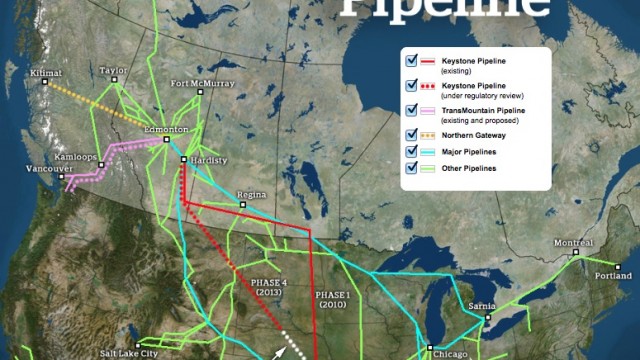
A detailed map of the oil pipelines running throughout Canada. Image taken from an interactive infographic at CBC.
The Two Mountains: Popular Opposition, Indigenous Resistance
Major obstacles remain to the project, which Enbridge hopes to operational by 2018; and those obstacles aren’t just the Rocky and Coastal mountains that lay in the proposed pipeline’s path.
For one, by all measures it is clear that the majority of B.C. residents oppose the project, even in Kitimat, B.C. Where one might expect to find the largest base of support given the concentration of jobs that would land in Kitimat’s small community of 9000, an April referendum saw 58% of voters oppose the project. The ruling parties at the Federal level and in B.C. are looking wearily at this as many a lost vote. Trudeau’s Liberals and Mulcair’s NDP have said they’d reverse the decision if elected in 2015. The Federal Green Party’s Elizabeth May, for her part, offered weak words of opposition saying that that “Next step is encouraging all British Columbians to use all democratic and peaceful and legal means to stop this pipeline.”
But beyond what’s legal and democratic is what’s ecological necessary and morally right, and such action is almost certainly forthcoming from the more firm opponents to be found amongst the Indigenous peoples of the northwest coast and interior nations.
First Nation communities must be “consulted” and won over as part of the 209 conditions that have been set out for Enbridge to meet – wise conditions for the Feds to set out, knowing that anything less would intensify the resistance that already exists to the project.
In December 2013, the First Nations Summit and Union of BC Indian Chiefs called upon the Feds to reject the Joint Review Panel’s recommendations and criticized the “the federal government [for] instead [chosing] to gut federal environmental protections, [and] unilaterally designed and imposed its greatly weakened environmental review process as a quick-and-dirty Aboriginal consultation process for the Enbridge Northern Gateway Project.”
In the wake of last week’s decision, Art Sterritt of the Coastal First Nations promised said in a statement that ““We’ll see if Enbridge dares to put its shovels in the ground… We will never allow oil tankers into our territorial waters.”
The Haida Nation added as unequivocally last week that: “We will take our fight to the land, sea and courts to uphold and protect Haida territory, and to ensure clean water, clean air, and a healthy way of life for future generations.”
Most importantly, perhaps, is the ongoing direct action by members of the Unist’ot’en Camp, who pledged to continue defending their territories “against the incursion of government and industry” in the wake of Northern Gateway’s approval.
Members of the Wet’suwet’en Nation erected a “soft blockade” in 2009 to block all pipeline projects trespassing upon their territories.
In a video statement released on June 17, two leading members of the Unist’ot’en Camp announced their resolve to continue their resistance. Toghestiy said “This war is far from being over. We’re going to win this one, and we’re going to win it decisively.”
Freda Huson reminded warned that “If they [the Canadian government] try to bring any forces, we’re more skilled in the wilderness than they are, so… We’re not afraid of the Harper government. We’re not afraid of anybody else who is going to try to forcefully push their projects through our territories.”
https://www.youtube.com/watch?v=MKLLEz_0R8M
So begins the delicate dance of Enbridge and its partners to find some ‘Aboriginal’ partners to give the project their blessings before proceeding further.
]]>On March 13, 2014, the Committee in solidarity with those affected by Chevron in Ecuador organized a forum “Exposing the Dirty Hand of Chevron,” as a part of a wider awareness campaign.
For the past 20 years Ecuadorian indigenous and peasant communities have been fighting a legal battle against the oil giant Chevron for what is the largest environmental oil-related crime of our time that has been left behind in the Ecuadorian rainforest. In 2012 Chevron was sentenced to pay damages of US$ 9.5 billion. However, the corporation no longer has any assets in Ecuador to be seized.
Therefore, in order to enforce the Ecuadorian judgment to indemnify and compensate the victims and survivors of the contamination left in Ecuador by Chevron, the Court of Appeal for Ontario ruled in December 2013 that Ecuadorian indigenous communities have the right to pursue all of Chevron’s assets in Canada.
Justice James MacPherson of the Court of Appeal for Ontario said that: “Chevron’s wish is granted. After all these years, the Ecuadorian plaintiffs deserve to have the recognition and enforcement of the Ecuadorian judgment heard on the merits in the appropriate jurisdiction. At this juncture, Ontario is that jurisdiction.”
Given that the legal battle against Chevron now continues here in Canada, several organizations and collectives in Toronto saw the need to create a Solidarity Network with the affected communities in Ecuador by Chevron.
During their initial meeting, held on January 16, 2014, they gathered to denounce the pollution that Chevron left in Ecuador and the serious impact this has had on the health of the indigenous and peasants living in the Ecuadorian Amazon. Participants also expressed their support in the struggle of the Ecuadorian government of President Rafael Correa to win a measure of justice in the courts and media against the powerful U.S. Corporation.
“How can it be possible that Chevron, colluding with a private arbitration centre, wants to make the Ecuadorian government responsible for paying the judgment of US$9.5 billion to the affected communities?” asked Janis Mills, a Canadian academic and activist.
In an effort to create awareness in Canada around this issue, the committee has organized various screenings, events and information series.
Nicole Oliver, who participated at one of these events, noted that “The battle against oil corporations is also happening here in Canada. For example, theUnist’ot’en are currently battling against Chevron and other companies in resistance to the Pacific Trails’ Pipeline in northern B.C. over unceded Wet’suwet’en territory.” Oliver also stressed that “we think that peoples from Canada and Ecuador have similar problems, in many cases, facing the same threats, such as corporations and Canadian companies, that put profit first over the common good. In this context we think that affected communities can learn and support each other beyond borders.”
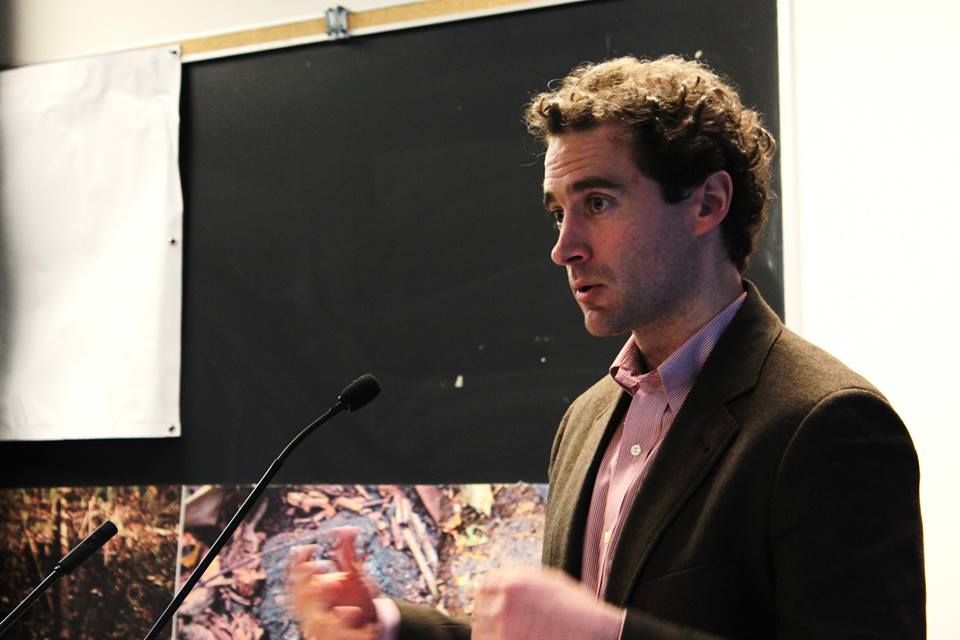
Brendan Morrison, Canadian lawyer representing the victims of Chevron in Canada. CAMILA URIBE-ROSALES, BASICS.
On March 13th, 2014 a forum was held at the University of Toronto with Brendan Morrison, Canadian lawyer representing the victims of Chevron in Canada, and Santiago Escobar, a human rights activist who has exposed and denounced the crimes of Chevron in the courts of both Ecuador and North America.
The forum began with the screening of a documentary on the crimes of Chevron, describing the hard evidence being used to legally challenge and sue the U.S. corporation for its chemical pollution. The screening described how Chevron’s pollution was the source of the rising epidemic of cancer and other health-related issues appearing for the first time throughout the Ecuadorian rain forest.
Brendan Morrison gave an overview of the legal battle during which he quoted Chevron’s spokesman’s declaration that the oil corporation “will fight [any legal challenge] until hell freezes over” and then “fight it out on the ice”.
“Chevron keeps refusing to accept responsibility for the environmental damage caused in the Ecuadorian Amazon, which as a result has generated high levels of cancer, abortions and various health problems among people living in areas contaminated by Chevron. It is time for this corporation to take responsibility,” said Toronto activist, Megan Kinch.
Santiago Escobar showed further fraud with proof of payments made by Chevron to Borja Diego Sanchez (known as “Chevron’s dirty tricks guy”) describing the collusion between the two. According to documents from Chevron, which emerged during Borja’s deposition in the U.S., Borja received over two million dollars in support to create propaganda for Chevron; ranging from use and payment of Chevron’s attorneys; a salary of ten thousand dollars; funding for his travels, among other various expenses.
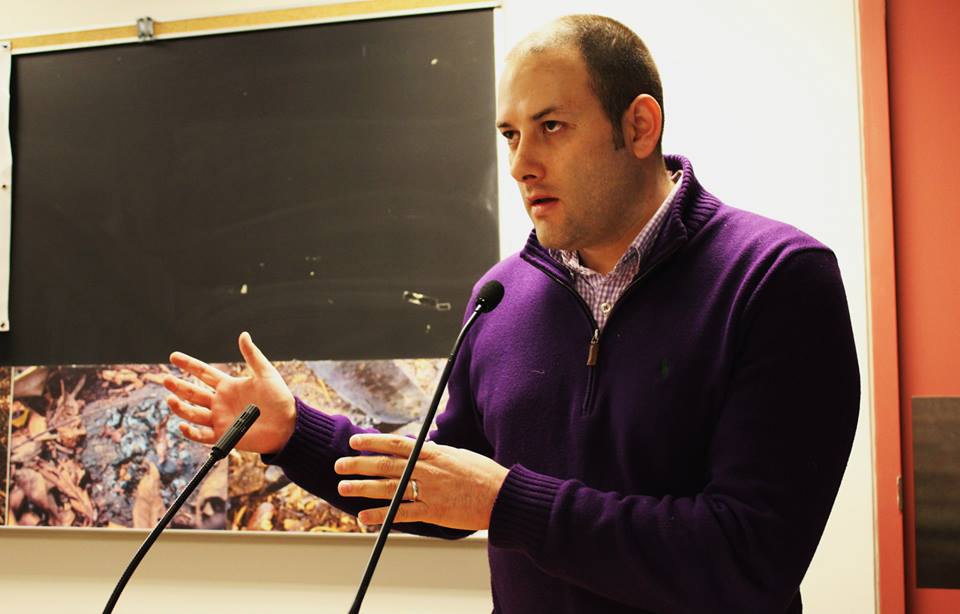
Santiago Escobar a Human Rights activist who has denounced the crimes of Chevron. CAMILA URIBE-ROSALES, BASICS.
“Chevron’s dirty tricks guy” first became known in September 2009, when Chevron used some videos he produced in which among other things, he created the impression that the judge proceeding the legal case of the affected communities against Chevron was being bribed. Chevron used these videos to accuse the government of Ecuador of inventing a false legal case for political reasons.
The forum came to an end with a photo exhibition documenting environmental damage caused by Chevron. All the participants created hand prints with black paint on canvas as a symbolic protest against Chevrons’ poisoning of the Ecuadorian Amazon.
On March 18th, at the University of Toronto, the Youth Communist League organized a Forum on Ecuador vs. Chevron, and Report-back from the World Festival of Youth and Students that was held last December 2013 in Quito, Ecuador.
Currently, several organizations and alliances in Canada are backing the Indigenous plaintiffs in Ecuador, including the Canadian and Quebec sections of the International League of People’s Struggles; the Hugo Chavez People’s Defense Front; La Red de Amigos de la Revolución Ciudadana; Hispanic Centre of York and Barrio Nuevo.
The Committee in Solidarity with those Affected by Chevron in Ecuador is comprised of people committed to social and environmental justice. If you want to join the cause, write to: [email protected] or follow them on : www.facebook.com/chevronsdirtyhand – https://twitter.com/chevronsdirty
International #antichevron Day! #May21. Endorse the Chevron’s Dirty Hand campaign today by emailing [email protected]!!!
]]>
In May 1970, National Guardsmen in the U.S. were called in to respond to a highly militant anti-war protests taking place at Kent State University in Ohio. The protests were an immediate, emergency response to then President Richard Nixon “spreading the war” from Vietnam itself into Cambodia. On May 4, these armed instruments of state power used the same weapons used against the Vietnamese revolution, and opened fire, killing four protesters.
Within a few weeks, Neil Young, with his on again/off again bandmates, Crosby, Stills and Nash, were in the recording studio recording a response which was on the radio within four days. The song explicitly situated itself as coming from “the movement” at a time when millions of Americans believed they were on the cusp of revolution at home. The governor of Ohio felt the same way, calling the protesters violent revolutionaries, and proclaiming that “these people just move from one campus to the other and terrorize the community. They’re worse than the brown shirts and the communist element and also the night riders and the vigilantes.”
“Ohio”, the sparse and angry song recorded that day wasn’t your typical protest anthem. It was neither a preachy message song or a simple pacifist chant that reduced the movement to giving “peace a chance”. Instead, it seethed about “tin soldiers” who had caused the four dead. Instead of giving peace a chance, it made the unambiguous plea “gotta get down to it, soldiers are cutting us down..should have been done long ago”. What should have been done, it seems, was revolution. Moving from the general to particular, it then addresses its listener, “What if you knew her and found her dead on the ground, how can you run when you know”?
Just as Neil Young did the right thing about the anti-war movement, he has the opportunity to do so on an issue at least as important. With that in mind, I’d like to turn the questions that Mr. Young raised in “Ohio” back onto Mr. Young. Mr. Young , think of the Palestinian people killed by Israeli weapons or the quiet weapon of starvation and open-air prisons. What if you knew them? How can you run when you know? Let us not forget the treatment of Africans by the Israeli state, migrant workers who have been as of late agitating for their rights. Israel’s racist attitudes, far right hate groups and mounting detentions against Africans is not dissimilar to that of the “Southern Man” that Mr. Young inveighed against not too long after recording “Ohio”. Would Neil be “Rocking in the Free World” by playing Israel? Is this in the interests of the dispossessed “patch of ground people”, or the interests of “Vampires” that “Sell you twenty barrels worth”.

Neil Young speaking at a press conference for the “Honour the Treaties” tour, a series benefit concerts that were held to raise money for legal fight against the expansion of the Athabasca oilsands in northern Alberta and other similar projects, in Toronto, Sunday January 12, 2014. (THE CANADIAN PRESS/Mark Blinch)
Even very recently, Young has proven himself to be on the correct side of the question of the day’s most pressing issues. Young has been a lifelong supporter of indigenous struggles, not merely in the form of his songs, like Pocahontas, but in his actions, most recently in his “Respect the Treaties” tour and publicity event. For this sin against Canadian interests, Neil Young was attacked in the corporate media and even by the Prime Minister’s office. This was perhaps one of the most effective political interventions made by a cultural icon in Canada in recent years, and at least so far as I remember. The Two Row Times praised Young’s integrity, calling him “a deeply spiritual man with the heart of a prophet, who has pointed the way to the future for nearly three generations of young people.” Neil Young seemed to be the Anti-Bono. As opposed to palling around with George W. Bush and Bill Gates, ostensibly in the service of helping “poor Africans”, Young has taken the lead in what is one of the most important and pressing issues within Canada’s borders.
It is for this reason, more than any, that progressives must demand that Mr. Young cancel his concerts in Apartheid Israel this summer . How can Neil maintain this deeply felt and deserved reputation, as a craftsman, a guitar visionary, a wise man, if he were to betray every principle that culminated in his recent interventions?
It is not unlikely that Mr. Young is aware of the calls for Boycott, Divestment and Sanctions. From Gil Scott Heron to Elvis Costello, progressive musicians – and even those not necessarily known for their politics (the Pixies, Annie Lennox, Massive Attack) – have responded to the call by cancelling and/or not booking shows in Israel. Perhaps Neil Young has been informed – even by the people with whom he just concluded a tour – that there were those calling for him to show his principles, and perhaps his attitude is that it would be hypocritical for him to play Toronto and then not play Tel Aviv. Yet there has not been a call from indigenous communities in Canada for a cultural boycott of Toronto. There is, however, a standing call for a cultural boycott of Israel.
Neil Young has sang that he is “proud to be a union man”, a member of the American Federation of Musicians. He should realize, then, that the Palestinian labour movement has explicitly called for a cultural boycott. Mr. Young – I know that it may be annoying that you are being addressed after the fashion of Lynyrd Skynyrd’s denunciation of you, but if the shoe fits… But please, “how can you run when you know?”
We all hope you do the right thing, Mr. Young.
]]>by Santiago Escobar
As the Unist’ot’en continue their protracted battle against Chevron and other companies in resistance to the Pacific Trails Pipeline in northern B.C. over unceded Wet’suwet’en territory, Indigenous peoples of the Amazon Rain Forest in Ecuador are pursuing Chevron in Canada for damages in one of the largest oil-related catastrophes in history.
This past December 2013, after twenty years of legal battles with America’s third largest corporation – ranking 11th in the world – the 30,000+ Indigenous plaintiffs of Ecuador made a small step forward when an Ontario Court of Appeal ruled that they could pursue Chevonr for damages they were awarded in the Ecuadorian courts. But the battle is far from over.
Between 1964 and 1990, U.S. oil giant Texaco (now Chevron) deliberately contaminated Ecuador’s Amazon rainforest by dumping some 18 billion gallons of toxic wastewater, among other contaminants, leaving in its wake pollution levels 30 times higher than the Exxon Valdez disaster in Alaska. What has been called Amazon’s ‘Chernobyl’ has led to a proliferation of miscarriages, birth defects, and cancer rates that are thirty times higher than elsewhere in the country. Scientific readings of the toxicity of water and soil in the region have revealed levels thousands of times above what is permitted by both Ecuadorian and U.S. law. And it’s the region’s Indigenous inhabitants – which includes the Quechua, Siona, Cofan, Secoya and Huaorani peoples – who are bearing the brunt of the genocidal effects of the Amazon’s destruction. The Tetetes and the Sansahuari peoples have already been killed off by Chevron’s activities.

The battle with Chevron is just one of many faced by Ecuador and its inhabitants in the face of U.S. corporate interests and imperialist military operations in the region, including the militarization of Colombia, which has in the past already launched military attacks into Ecuador. For his part, Ecuador’s President Rafael Correa has opposed U.S. manoeuvres in the region, launching the campaign “Dirty Hands” against Chevron.
Chevron has used all the “legal” resources at its disposal to avoid compensating those affected in Ecuador. According to the indigenous plaintiffs, Chevron has a legal army with more than 60 legal firms, some 2,000 legal professionals, top-notch public relations firms, the shadowy “investigative and risk” management firm Kroll. In 2013 alone, Chevron spent $400 million alone in 2013 for “legal services” that have been deemed “unethical”. “This is probably the most money any company in history has spent defending itself on environmental claims,” said Aaron Page, a U.S. lawyer for the Ecuadorians. “The total legal cost for Chevron shareholders is likely approaching $2 billion and it is rising fast.”
In addition to the ‘legal’ means at its disposal to defeat the case, Chevron has also employed a whole series of other dirty tricks to undermine the lawsuit, including: harassing the plaintiffs’ legal team, several bribery attempts, and undercover plots such as setting a trap to the judge overseeing the case in Ecuador.
 After nearly 20 years of battle, in 2011 an Ecuadorian court ruled that Chevron had to pay for the destruction that it caused and was required to compensate the victims. On December 11, 2013 the Supreme Court of Ecuador ratified the ruling and set the final amount owed at US$9.5 billion.
After nearly 20 years of battle, in 2011 an Ecuadorian court ruled that Chevron had to pay for the destruction that it caused and was required to compensate the victims. On December 11, 2013 the Supreme Court of Ecuador ratified the ruling and set the final amount owed at US$9.5 billion.
The plaintiffs are now trying to gain justice in several courts across the globe, including Canada, since Chevron no longer has assets remaining in Ecuador. On December 17, 2013, the Ontario Court of Appeal ruled that Ecuador’s Indigenous communities indeed have the right to pursue Chevron’s assets in Canada to enforce the US$9.5 billion Ecuador judgment. Chevron’s assets in Canada are currently estimated at US$15 billion. Thus, the entirety of the Ecuador judgment can be collected in Canada if the communities prevail on their enforcement action.
Referring to comments from a Chevron spokesman that the company would “fight this until hell freezes over” and then “fight it out on the ice,” Justice James Mac Pherson of the Court of Appeal for Ontario said that: “Chevron’s wish is granted. After all these years, the Ecuadorian plaintiffs deserve to have the recognition and enforcement of the Ecuadorian judgment heard on the merits in the appropriate jurisdiction. At this juncture, Ontario is that jurisdiction.”
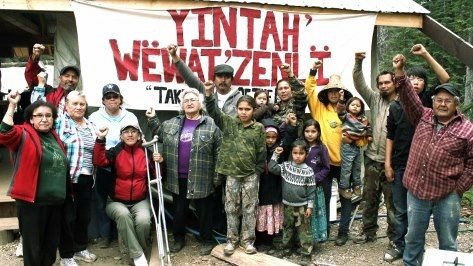
An image from the Unist’ot’en Camp, Freda Huson sitting to the left with the crutches.
Indigenous peoples in Canada will be watching the ruling closely, as the notorious polluter pursues development of the Pacific Trails pipeline through unceded Wet’suwet’en territory in central B.C.
In an interview with BASICS, Freda Huson, a spokesperson for the Unist’ot’en, said, “We are protecting the Morice River and Gosnell creek, which feed into the Bulkley River. Salmon is one of our main staple food that spawn in Gosnel and swim down stream into Bulkley.” The Unist’ot’en built a cabin near the initial route of the proposed pipeline in 2010, which forced a route change for the Pacific Trails Pipeline.
Huson told BASICS Community News Service that “We have since constructed a traditional pithouse on their new proposed route. We have people living at the site blocking the only bridge into our territory. We stand in solidarity with many other nations struggles against industry destruction.”
Currently, several organizations and alliances in Canada are backing the Indigenous plaintiffs in Ecuador, including the Canadian and Quebec sections of the International League of People’s Struggles; the Hugo Chavez People’s Defense Front; Red de Amigos de la Revolución Ciudadana; Centro Comunitario San Lorenzo; and Barrio Nuevo.
The alliances are planning to have the first meeting of a Solidarity Committee at 6:30pm on January 16, 2014 at the Hispanic Centre of York, 1652 Keele St., Toronto.
]]>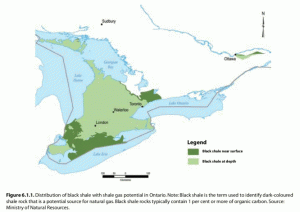
These shale deposits were highlighted in a 2010-2011 report from the Ontario Environmental Commissioner.
by Steve da Silva
With the consciousness of people in Canada taken up a notch on the issue of “fracking” by the Mi’kmaq-led resistance in New Brunswick, it’s only a matter of time before people’s sights and struggles shift to the next major shale-gas frontier: Ontario. The US Energy Information Administration estimated in 2013 that there were 573 trillion cubic feet of recoverable natural gas in Canada.
“Fracking,” or hydraulic fracturing, is the process by which oil is withdrawn from harder to access sources by blasting water, sand, and chemicals into shale rock formations.
High gas prices have opened the way for the oil industry to push fossil fuel exploitation into the realm of more difficult to reach fossils fuels, what are known as “the unconventionals”: tar sands, shale-gas, and deep-water oil wells.
Most people in Ontario are unaware that a Canadian oil firm out of Alberta has for years been acquiring land rights across southwestern Ontario, in order to explore and drill the extensive shale-gas deposits in the province. Although up-to-date information on its operations are scarce, by 2011 Mooncor Oil and Gas Corp. already owned some 20,000 acres of land in Chatham-Kent and Lambton County, in southwestern Ontario.
In Ontario, geologists have broken down shale-gas deposits into three major zones: the Kettle Point Formation known as Antrim Shale; the Collingwood-Blue Mountain formations known as Utica Shale; and the northernmost limit of the Marcellus Shale that extends up from Pennsylvania and New York State.
While Ontario shale-gas exploration is reported to have not yet used the fracking method, the even greater danger of tapping shale-gas is the planetary danger posed by carbon emissions through new fossil fuel exploitation. Although natural gas emits half the greenhouse gas that coal gives off, most of the world’s proven reserves of fossil fuels cannot be exploited without initiating irreversible levels of climate change.
]]>The verdict couldn’t be clearer: we are destroying and degrading the Ocean at a pace not even anticipated by the experts just two years ago.
This is the forecast of the Global State of the Oceans Report, by a body of the world’s leading marine scientists along with international marine governance officials. The report takes a holistic, “earth systems” approach to studying the state of the oceans, as opposed to artificially isolating problems into specific locales or species.
The ocean makes up one of the primary systems in Earth’s overall ecological system, and the report acknowledges that its role as an overall regulator is being compromised by human activity.

Oil spills like BP’s Deepwater Horizon are actually just the “tip of the iceberg” when it comes to the destruction and degradation of the Ocean. Global warming and CO2 emissions actually pose the greater threat – which, ultimately, comes back to a fossil fuel-driven economy.
The report warns, “the window of opportunity to take action is narrow. There is little time left in which we can still act to prevent irreversible, catastrophic changes to marine ecosystems as we see them today.”
Many may think that the most immediate threats to the ocean are coming from industrial pollutants and overfishing – which are indeed major problems. The 80-90 million tons of fish caught every year is rapidly depleting fish stocks and the larger food webs they are a part of. Meanwhile, pollutants from profit-driven industrial activities and agricultural run-off are depleting the oxygen levels in in the ocean and creating large “dead zones”.
Yet, the greatest threat of all to the Ocean’s role in the earth system is climate change. As carbon emissions rise, so too is the extent to which they are absorbed by the ocean, which is leading to ocean acidification with disastrous consequences for marine life.
Yet, while the writing on the wall spells out Earth-system collapse if drastic changes are not made to our economy’s relationship to the Earth, the report falls short of putting forward the radical solutions needed, pointing instead in the direction of policy actions within the same economic system. It comes as little surprise, given the reports main audience are “policy makers,” which is to say mostly people invested in the status quo.

This image from the NASA Earth Observatory shows zones in the ocean where oxygen levels have dropped so low that these have become complete “dead zones”. However, the zones marked here should lead one to believe that ocean transformation is limited to these places. As the Oceans Report indicates, the entire Ocean as a system and connected to the Earth System are threatened.
The report concludes that “Without decisive and effective action, no region or country will be immune from the socioeconomic upheaval and environmental catastrophe that will take place – possibly within the span of the current generation and certainly by the end of the century. It is likely to be a disaster that challenges human civilisation.”
]]>
Activist being arrested at occupation of Enbridge Pumping Station north of Hamilton (rabble.ca)
by Kitchener-Waterloo BASICS
In an attempt to reverse the flow of highly-corrosive tar sands bitumen through the Haldimand Tract (Six Nations land), the Calgary-based oil company Enbridge is using the ageing Line 9 pipeline. The company is moving forward without the consent from the indigenous peoples whose way of life is directly threatened by the pipeline which has been built on the land where they live.
The danger with pumping is that bitumen is an unprocessed tar sands oil that is mixed with a highly-corrosive natural-gas liquid, and needs to be pumped at a higher temperature and pressure due to its viscosity. As a result, this puts a heavy strain on the aging 38-year-old pipeline. Pumping this oil also comes with a lot of waste that is pumped back into the Athabasca River system, which has an extremely negative effect on the surrounding environment.
Over the years, Enbridge has been dangerously careless when pumping tar sands oil through their pipelines. Between 1999 and 2010, Enbridge has reportedly been responsible for at least 800 spills (approximately 7 million gallons of heavy crude oil). One of the most devastating examples is the 2010 Line 6B spill in the Kalamazoo River in Marshall, Michigan. The effects of that spill were massive, and three years and almost one billion dollars later, the spill is still not completely cleaned up. Both Line 9 and 6B were built to transport conventional crude oil, not bitumen.
KW is showing resistance through a coalition of broad-based community organizations who oppose the proposal of the reversal of tar sands oil. Malcolm of Kitchener Ontario Animal Liberation Alliance said, “there was an occupation of the Enbridge Westover pumping station on Beverly Swamp, resulting in delaying the reversal through the area. This inspired people to take action in their own communities. This dirty tar sands oil not only puts people at risk, but also wildlife in the environment as well”.
“Here in Kitchener we have put forward a declaration and used it as a tool to get support from the community. By having info nights, lobbying, and organizing around this declaration, we hope to pressure the council to oppose this attack on our communities,” says Joe Campbell, community organizer.
KW organizers believe that we as a community need to work in solidarity with the indigenous peoples of this land to stop the reversal of the tar sands oil through this land before it’s too late and we have our own Kalamazoo on our hands. For more information, you can visit http://noline9wr.ca/.
]]>
Chief Aaron Sock (center, button-up shirt) of the Elsipogtog First Nation flanked by warriors and protesters after declaring that his community is reclaiming all unoccupied Crown Lands, which comprise much of modern day New Brunswick. Photo Credt: Miles Howe of the Halifax Media Coop.
After months of arrests and mounting resistance against shale gas exploration in New Brunswick on Mi’kmaq territory, the anti-fracking movement upped the ante this past week with a fresh blockade and a proclamation of a massive land reclamation, which has forced conservative New Brunswick Premier David Alward to a negotiation table with representatives of the anti-fracking movement.
A day after the September 30 blockade was established on Route 134 that blocked the entrance to an equipment storage site of SWN Resources Canada, Chief Aaron Sock, speaking for Chief and Council of the Elsipogtog First Nation, announced a sweeping Mi’kmaq land reclamation effective immediately.
“Harper and the Conservative government have lifted restrictions to environmental protections of our lands and water” and “the provincial government is turning over all lands… to a corporation for their own benefit… we have lost confidence in governments for the safekeeping of our lands.”
Sock added that “our notice of eviction has been completely ignored by the Provincial government and Southwest Energy, and… we have been compelled to act to save our water, land and animals from ruin.”
“Let it be known to all the we as the chief and council of Elsipogtog are reclaiming all unoccupied reserve lands… We have been instructed by our people that they are ready, willing, and able to go out and stake their own claims on all unoccupied lands for their own use and benefit.”
The October 1 announcement, which came on their Treaty Day, was read at the blockade site to an exuberant crowd of hundreds who gathered from across Kent County and beyond.
 The New Brunswick government has been allowing SWN Resources to explore some 2.5 million acres of lands for the purpose of shale gas extraction through hydraulic fracturing, or “fracking”. Fracking involves drilling deep wells that fracture shale rock beds and requires the pumping of millions of gallons of pressurized fresh water and toxic chemicals, including known carcinogens and neurotoxins, into a well to force the gas out. However, the provincial government’s case for hydraulic fracturing took a huge blow this past September when Louis LaPierre, the researcher at the New Brunswick Energy Institute who wrote the report encouraging the government to proceed with gas exploitation, was discovered to have lied for decades about having a PhD in Ecology.
The New Brunswick government has been allowing SWN Resources to explore some 2.5 million acres of lands for the purpose of shale gas extraction through hydraulic fracturing, or “fracking”. Fracking involves drilling deep wells that fracture shale rock beds and requires the pumping of millions of gallons of pressurized fresh water and toxic chemicals, including known carcinogens and neurotoxins, into a well to force the gas out. However, the provincial government’s case for hydraulic fracturing took a huge blow this past September when Louis LaPierre, the researcher at the New Brunswick Energy Institute who wrote the report encouraging the government to proceed with gas exploitation, was discovered to have lied for decades about having a PhD in Ecology.
On Wednesday, October 2, a new Brunswick court issued an injunction against the blockade at the request of SWN, which is enforceable until October 12, 2013. But the papers have yet to be served by the RCMP, and Miles Howe of the Halifax Media Co-op has reported that the RCMP would not enforce an injunction until dialogue with the Premiere had ceased.
On Sunday, October 5 Premier Alward and three members of his cabinet met with and the Elsipogtog chief and 15 representatives of the protesters for three hours in a Moncton hotel, with negotiations continuing in Fredericton as of Monday. The delegation reportedly excluded the Mi’kmaq Warriors Society, who Alward would not meet with, and who have reportedly been the main and most visible force at the blockade. The Warriors are independent of the Chief and Council.
Two Row Times asked Elsipogtog counsellor Robert Levi whether the negotiations that had opened up related to the blockade or the larger land reclamation, and Levi told us that “I think the [reclamation] is a larger issue that will take on a life of its own. But since we have an injunction hanging over our heads, this is what needs to be resolved right now, since we want a peaceful resolution to the blockade and for no one to get hurt.”
On October 7, the Mi’kmaq Warriors Society took their own initiative and hand-delivered a letter (via a Houston-based environmentalist group) to SWN Resources reading, “all projects, leases, and permits issued to SWN Resources by the Government [of New Brunswick] come to a halt until all Mi’kmaq-L’nu, and Wabanaki communities, as sovereign individuals are Meaningfully Consulted, and that we are able to come to an informed decision as individuals.”
 All the while, the Acadian presence in the anti-fracking movement and at the most recent blockade has also been quite strong, which many see as a welcome development between the two communities. Fourteen years ago, the crisis of Burnt Church unfolded 100 km to the north, where non-native fishers destroyed thousands of Mi’kmaq lobster traps to protest native fishing rights, which was followed by violent confrontations. However, Acadians and Mi’kmaq have also had strong of unity against a common oppressor in the region’s history. After the mass expulsion of the French-speaking Acadian people by the British in 1755, the remaining Acadians and the Mi’kmaq made a treaty that saw the two peoples unite in a guerilla war against the British that led to the 1757 defeat of a British detachment in 1757 in the Battle of Bloody Creek.
All the while, the Acadian presence in the anti-fracking movement and at the most recent blockade has also been quite strong, which many see as a welcome development between the two communities. Fourteen years ago, the crisis of Burnt Church unfolded 100 km to the north, where non-native fishers destroyed thousands of Mi’kmaq lobster traps to protest native fishing rights, which was followed by violent confrontations. However, Acadians and Mi’kmaq have also had strong of unity against a common oppressor in the region’s history. After the mass expulsion of the French-speaking Acadian people by the British in 1755, the remaining Acadians and the Mi’kmaq made a treaty that saw the two peoples unite in a guerilla war against the British that led to the 1757 defeat of a British detachment in 1757 in the Battle of Bloody Creek.
]]>
Canadian Natural Resources Ltd. is now taking drastic measure of emptying out two-thirds of Cold Lake in Alberta to contain the spilling of bitumen at no less than four sites at its Cold Lake project for over a month now. More than 1.5 million liters of bitumen (a mixture of oil sands, heavy crude and water) is said to have leaked. The bitumen leaked would fill 9600 barrels.
The site of the oil spill is on Treaty 6 territory near the Denesuline (‘Chipewyan’) community of Cold Lake First Nation, a community of the larger Dene nation in central Alberta.
The leak is being caused by the process whereby high-pressure steam that is pushed into the ground to force bitumen out a well. But instead, the bitumen is seeping through unknown cracks in the ground, damaging local land, water, and wildlife. The most difficult leak to contain is in lake, where the bitumen is pushing through the ground under the water.
The Cold Lake First Nation is demanding answers for the leaks, which are damaging traditional hunting grounds. A statement from the Cold Lake First Nation claims that the number of known sites where bitumen is pushing through the ground has grown to six.
“I’m really distressed about the safety of our drinking water, animals, vegetation and how this is affecting the aquifers underneath our Dene lands. Our future generations will not be able to enjoy what once was pristine Denesuline territory. Animals such as wolves and bears are now migrating through our community, which is a safety risk and precaution. The environment is changing and definitely not for the positive,” stated Chief Bernice Martial.
The Cold Lake First Nation works with some twenty oil companies in its region.
]]>

